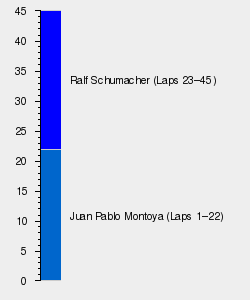2001 German Grand Prix
The 2001 German Grand Prix (formally the LXIII Großer Mobil 1 Preis von Deutschland) was a Formula One motor race held on 29 July 2001 at the Hockenheimring, Baden-Württemberg, Germany. It was the twelfth round of the 2001 Formula One season and the 63rd German Grand Prix. The 45-lap race was won by Williams driver Ralf Schumacher after starting from the second position. Rubens Barrichello finished second for Ferrari with BAR driver Jacques Villeneuve third scoring his last F1 podium finish.
| 2001 German Grand Prix | |||
|---|---|---|---|
| Race 12 of 17 in the 2001 Formula One World Championship | |||
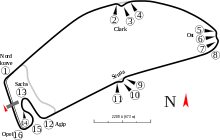 Hockenheimring (last modified in 1994) | |||
| Race details | |||
| Date | 29 July 2001 | ||
| Official name | LXIII Großer Mobil 1 Preis von Deutschland | ||
| Location | Hockenheim, Baden-Württemberg, Germany | ||
| Course | Permanent racing facility | ||
| Course length | 6.823 km (4.240 mi) | ||
| Distance | 45 laps, 307.035 km (190.792 mi) | ||
| Weather | Partially cloudy, very hot, dry, Air: 28 °C (82 °F), Track: 32 °C (90 °F) | ||
| Attendance | 100,000 | ||
| Pole position | |||
| Driver | Williams-BMW | ||
| Time | 1:38.117 | ||
| Fastest lap | |||
| Driver |
| Williams-BMW | |
| Time | 1:41.808 on lap 20 (lap record) | ||
| Podium | |||
| First | Williams-BMW | ||
| Second | Ferrari | ||
| Third | BAR-Honda | ||
|
Lap leaders
| |||
Juan Pablo Montoya started from pole position alongside Ralf Schumacher. Michael Schumacher, the eventual Drivers' Champion started fourth, behind Mika Häkkinen of McLaren. The race was marked by an airborne accident going into the first corner involving Michael Schumacher and Luciano Burti for Prost, which caused the track to be scattered with shreds of carbon fibre and the race restarted as a result. Both Williams drivers retained their positions at the end of the first lap, with Michael Schumacher passing Häkkinen for third. Over the course of the race, Montoya extended a considerable lead over Ralf Schumacher. Montoya lost the lead on lap 24 when an issue with a refueling rig caused him to be stationary for more than 20 seconds. Ralf Schumacher thus inherited the lead and held it to win his third victory of the season.
As a consequence of the race, Michael Schumacher retained his points advantage in the Drivers' Championship over nearest rival David Coulthard as both drivers retired from the event. Ralf Schumacher moved ahead of Barrichello to take over third position. In the Constructors' Championship, Ferrari retained their lead, while Williams reduced the deficit to McLaren by ten points, with five races of the season remaining. This was the last Grand Prix to be held on this layout; the race was held on a shorter reconfigured track starting in 2002.
Background
The Grand Prix was contested by eleven teams with two drivers each. The teams (also known as constructors) were Ferrari, McLaren, Williams, Benetton, BAR, Jordan, Arrows, Sauber, Jaguar, Minardi and Prost.[1]
Going into the race, Ferrari driver Michael Schumacher led the Drivers' Championship with 84 points, ahead of David Coulthard on 47 points and Rubens Barrichello with 34 points. Ralf Schumacher was fourth on 31 points, and Mika Häkkinen was fifth on 19 points.[2] In the Constructors' Championship, Ferrari were leading with 118 points, fifty-two ahead of second place team McLaren. Williams were third on 46 points, while Sauber with 19 points, and Jordan on 15 points contended for fourth place.[2] Ferrari, McLaren and Williams had so far secured all eleven victories of the season. Championship drivers Barrichello and Juan Pablo Montoya had secured second place podium finishes, while Nick Heidfeld, Jacques Villeneuve and Eddie Irvine had all achieved third place podium finishes.[2]
After the British Grand Prix on 15 July, eight teams conducted mid-season testing at the Autodromo Nazionale Monza between 17–20 July to prepare for the upcoming German Grand Prix at the Hockenheimring.[3] Ricardo Zonta set the fastest times on the first day, ahead of McLaren test driver Alexander Wurz.[3] Michael Schumacher lost control of the rear-end of his car at the Seconda Variante chicane, causing him to slide along the barriers and his car rested in the tyre barriers. Testing was suspended for one hour for the barriers to be repaired.[4] Ferrari later found the crash occurred by a broken diffuser from riding on the kerbs which created a loss of downforce under braking.[5] Michael Schumacher took a medical check and was declared fit to race.[6] Ralf Schumacher was fastest on the second day where it was held in wet weather conditions during the afternoon.[3][7] Sauber and BAR went to Circuit Ricardo Tormo for three days where aerodynamic and set-up testing was undertaken.[5][7] Coulthard was scheduled to join Wurz during the session but withdrew because of food poisoning.[7] Irvine was quickest on the third and final days of testing.[3] Arrows elected not to perform any testing and concentrated on work on aerodynamics at their headquarters at Leafield.[5]
There was one driver change heading into the race. Having been in one of the Jordan cars since the first race of the season in Australia, Heinz-Harald Frentzen was sacked by his team and was replaced by Jordan's third driver Zonta.[8] Frentzen announced he would take legal action against Jordan and team principal Eddie Jordan said that Frentzen's management was not happy with Jordan's current performance but denied rumours that a heated row occurred.[9] The Schumacher brothers were sympathetic towards Frentzen who felt unhappy about the manner in which he was sacked.[10] Irvine came to Jordan's defence and said that he believed the decision was influenced by problems Jordan had with 1996 World Champion Damon Hill who had similar poor performances like Frentzen.[11] In an interview with The Sunday Independent in 2005, Jordan later claimed that Frentzen was sacked because engine supplier Honda wanted Japanese driver Takuma Sato to race for Jordan in 2002 and to retain Honda's engine supply.[12] During the week of the race, the organisers of the German Grand Prix signed an extension to continue hosting the event at the Hockenheimring until 2008 with an option for a further five years.[13]
Some teams made modifications to their cars in preparation for the Grand Prix. Williams, Jaguar, Ferrari, Sauber and Prost all brought updated front wings.[14][15] Ferrari also introduced a new underfloor and brought more powerful versions of their V10 engines for qualifying and the race.[14] Williams installed extra cooling on their cars to combat high temperatures in qualifying.[16] Minardi planned to introduce a new revision to their cars aerodynamic package which included a new engine cover, a titanium gearbox and rear suspension geometry. The team decided to only test the gearbox during the first free practice session.[17]
Practice
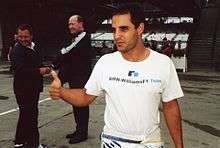
Four practice sessions were held before the Sunday race—two on Friday, and two on Saturday. The Friday morning and afternoon sessions each lasted an hour. The third and final practice sessions were held on Saturday morning and lasted 45 minutes.[18] The Friday practice sessions were held in dry and hot weather conditions.[14] Barrichello set the fastest time in the first practice session, at 1 minute and 41.953 seconds, which was three-tenths of a second quicker than Pedro de la Rosa of Arrows. Coulthard was third fastest despite going off the circuit at the Clark chicane. Michael Schumacher went off at the Senna chicane en route to recording the fourth quickest lap, ahead of Ralf Schumacher. Häkkinen, Montoya, Irvine, Giancarlo Fisichella and Jarno Trulli rounded out the top ten fastest drivers in the session.[19] In the second practice session, Irvine was running quicker by setting the fastest time of the day of 1:41.424, ahead of Montoya in second. Häkkinen was third quickest, in front of Barrichello in fourth. Michael Schumacher took fifth place, running wide at the circuit's chicanes which prevented him from setting a quicker lap. de la Rosa, Coulthard, Jean Alesi, Trulli and Ralf Schumacher, who collided with the Sudkurve tyre barrier, followed in the top ten.[20]
The weather remained hot and dry for the Saturday practice sessions.[21] Michael Schumacher was the quickest driver in the third practice session, with a time of 1:39.937. Barrichello was second quickest, almost half a second slower than Michael Schumacher. The two Williams drivers were third and fourth; Ralf Schumacher ahead of Montoya. Coulthard secured the fifth fastest time, two-tenths of a second faster than teammate Häkkinen in sixth. Heidfeld, Villeneuve, Irvine and Kimi Räikkönen rounded out the top ten. Benetton driver Jenson Button did not set a time.[22] In the final practice session, Ralf Schumacher was the quickest driver with a lap of 1:39.188, almost three-tenths of a second ahead of Montoya. Michael Schumacher was unable to improve his time from the previous session and was third fastest. He was ahead of Häkkinen in fourth, Heidfeld was fifth and Barrichello sixth. Irvine was seventh and Panis eighth. Coulthard, who beached his McLaren in the Agip corner gravel trap, took ninth and Trulli completed the top ten ahead of qualifying.[23]
Qualifying
Juan Pablo Montoya, commenting on taking pole position.[24]
Saturday's afternoon one hour qualifying session saw each driver limited to twelve laps, with the starting order decided by the drivers' fastest laps. During this session, the 107% rule was in effect, which necessitated each driver set a time within 107 per cent of the quickest lap to qualify for the race.[18] The session was held in dry and hot weather conditions.[16][21] Montoya clinched his first pole position of his Formula One career, with a time of 1:38.117.[25] Although he was pleased with his starting position, he was surprised at his team's performance in qualifying;[25] Montoya lost two tenths of a second in the second sector and found time in the stadium section.[16] He was joined on the grid's front row by teammate Ralf Schumacher who recorded a lap 0.019 seconds slower than Montoya who displaced Schumacher from pole during the middle of qualifying.[16] It marked the first time since the 1997 British Grand Prix that both Williams cars began a Formula One race from the first two starting positions.[25] Häkkinen qualified third and praised the handling of his car for his good performance. Michael Schumacher secured fourth and was disappointed not to be ahead of the two McLaren cars. Coulthard started fifth having suffered from tyre blistering and conserved his tyre use by abandoning his final qualifying run. Barrichello managed sixth having been unable to improve his time because of a spin. Behind the leading six, the two Sauber cars were seventh and eighth, Heidfeld qualifying in front of Räikkönen, with both drivers having their cars modified helping them to run faster (Heidfeld adjusted his set-up while Räikkönen raised his ride height for his third run).[16]
De la Rosa and Irvine qualified in ninth and eleventh positions respectively for Jaguar; the pair were separated by Trulli in the Jordan who's engine failed on his third run and was unable to return to the pit lane to use his team's spare car. The three drivers were ahead of Villeneuve in the faster of the two BAR cars, who in turn, qualified in front of teammate Panis; both drivers struggled to find grip throughout the one-hour period.[16] Alesi qualified in 14th position, more than four tenths of a second in front of Prost teammate Luciano Burti;[25] the latter spun off in the circuit's stadium section which caused a yellow flag to be shown. The two were split by Zonta in the slower Jordan car who drove over a kerb at the Senna chicane on his third run of the session which lost him time and he encountered slower cars.[16] The Benetton cars filled the ninth row of the grid with Fisichella 17th and Button 18th;[25] the latter's car had its gearbox changed and pulled to the side of the track with a failed engine.[16] Behind them, the Arrows drivers managed to qualify in 18th and 19th; Enrique Bernoldi qualifying ahead of Jos Verstappen.[25] Bernoldi improved his car's handling although his potential best run was disrupted because of Button's engine failure and Verstappen spun on his final timed lap.[16] The starting order was completed by Fernando Alonso and Tarso Marques in the Minardi cars.[25]
Qualifying classification
Warm-up
The drivers took to the track at 09:30 Central European Summer Time (UTC+2) for a 30-minute warm-up session.[18] It took place in dry weather conditions. Both Williams drivers maintained their good place from qualifying; Ralf Schumacher had the fastest time, 1:42.621. Montoya finished with the second fastest time. Coulthard was third quickest, and Michael Schumacher completed the top four, one-tenth of a second behind Ralf Schumacher. Alonso spun at the Sudkurve corner and skated across the gravel trap towards the tyre barriers.[27]
Race
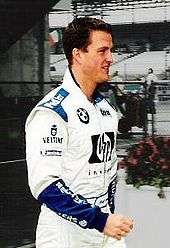
The weather conditions on the grid were dry before the race; the air temperature was 28 °C (82 °F) and the track temperature 32 °C (90 °F).[21] The race started at 14:00 local time.[21] A total of approximately 100,000 spectators attended the race.[28] As the drivers were preparing to start the formation lap, both Minardis were in the pit lane due to technical difficulties. Both Alonso and Marques initially started from the pit lane.[29] Both Williams drivers maintained first and second positions going into the first corner.[30] Further back, Michael Schumacher slowed with an issue with his gear selection,[29] which resulted in drivers being forced to swerve to avoid him.[30] Burti was unable to view the Ferrari as Panis was blocking his view and hit the rear of Schumacher's car,[29] launching Burti into the air and he rolled over the top on Bernoldi's vehicle's and narrowly landed on Verstappen's Arrows. Burti's car lost one of its wheels, landing of Bernoldi's Arrows which resulted in a broken engine cover and rear wing for the Brazilian.[30][31] Burti's car bounced across the gravel trap and came to a rest on the Nordkurve corner tyre barriers.[29] The race was red-flagged as strands of carbon fibre were scattered across the track and marshals were needed to clear the debris.[30]
Burti and Michael Schumacher cars had been damaged beyond repair, both were thus required to race their team's spare vehicles. The Minardi cars were able to undergo further repairs and both drivers started on the grid for the restart.[30] Barrichello's rear wing was replaced after Häkkinen made contact with him, for which the latter apologised.[31] At the restart, Montoya and Ralf Schumacher again held their positions, while Häkkinen led the Ferrari cars and his teammate Coulthard going into the first corner. Further down the field, de la Rosa lost control of his Jaguar as he braked late going into the Clark chicane entry and hit the Sauber of Heidfeld.[30][32] Michael Schumacher clinched third place from Häkkinen heading into the same area. Going into the stadium section, Barrichello passed Coulthard on the outside for fifth position.[30] Verstappen made the best start of the field, moving from 20th to eleventh by the end of the first lap, while Button made up five positions over the same distance. As the drivers completed the first lap, Montoya led by 1.4 seconds from Ralf Schumacher, who was followed in turn by Michael Schumacher, Häkkinen, Barrichello, Coulthard, Räikkönen, Irvine, Trulli, Villeneuve, Verstappen, Zonta, Button, Panis, Bernoldi, Fisichella, Burti, Alesi, Alonso and Marques.[33]
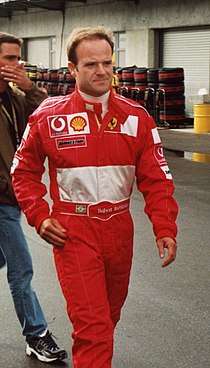
Montoya began to gradually pull away from Ralf Schumacher.[33] Bernoldi passed Fisichella to take 14th place on lap two.[30] Barrichello overtook Häkkinen at the Ostkurve corner to move into third one lap later.[29] Further down the field, Button lost 13th position when he was passed by Panis on the same lap. On lap five, Panis made up a further position as he overtook Zonta for twelfth, while Bernoldi passed Button to take 14th. Barrichello moved into second position after he overtook Michael Schumacher at the Senna chicane on lap six.[30] On the same lap, Zonta went into the rear of Verstappen's car, causing Zonta to lose his front wing.[29] Verstappen fell behind Panis after the collision.[30] Zonta made a pit stop for repairs, but retired after driving one exploratory lap.[29] Verstappen made his pit stop and rejoined at the back of the field. Alesi passed Burti to move into 15th position on lap nine, and Panis overtook teammate Villeneuve for tenth place one lap later.[30] On the tenth lap, Panis attempted to overtake Trulli for ninth by taking the inside line, but was unable to complete the manoeuvre. Panis again tried to pass Trulli but by taking the outside line on the next lap, although he could not execute the pass because of a lack of straight line speed.[34] During the twelfth lap, Panis made his third attempt at passing Trulli and managed to get ahead of the Italian. Trulli pulled into the slipstream of Panis, and attempted to reclaim the position but spun at the Ostkurve corner, and fell to 17th.[30][34]
Häkkinen retired from the race when he slowed and later pulled to the side of the track with fluid leaking from his engine on lap 14.[30][34] His retirement allowed Räikkonen to move into the first points-scoring position of sixth.[30] By lap 15, Montoya had a lead of 8.3 seconds over Ralf Schumacher, who in turn was 3.3 seconds in front of Barrichello. Michael Schumacher was a further 9.2 seconds behind his Ferrari teammate, but was drawing ahead of Coulthard in fifth. Barrichello and Panis were the first drivers to make scheduled pit stops on lap 16.[33] The Ferrari and Williams teams were employing different pit stop strategies – the Ferrari were planning a two stop strategy for Barrichello whereas the Williams team were only planning for one stop.[31][33] Räikkonen slowed on track with an driveshaft failure but managed to return to the pit lane and retire on the same lap, while Irvine retired with an misfiring engine.[29][30] Two laps later, Burti lost tenth position after he spun and was passed by Trulli and Panis.[30][34] Barrichello attempted to get past Coulthard for fourth position on lap 19, but Coulthard moved onto a defensive line to keep the position.[34] Montoya continued to pull away from Ralf Schumacher—setting the race's fastest lap of 1:41.808 on lap 20—to maintain his first position after his one and only pit stop.[29][33] Barrichello was able to overtake Coulthard at the Agip corner on the same lap.[29]
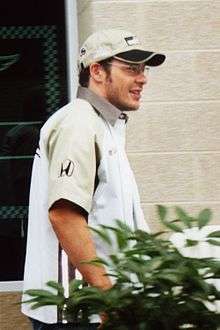
Montoya made his pit stop on lap 22.[33] However, his pit stop proved problematic: the signal lights at his pit box stopped working, causing the Williams refuller to switch to the fuel rig for Ralf Schumacher and Montoya remained stationary for 20 seconds longer than usual. Montoya was also fuelled for longer than his team planned.[29][32] Ralf Schumacher thus inherited the lead with Michael Schumacher behind him and Montoya re-emerged in fourth place.[33] One lap later, Michael Schumacher took his pit stop and he came out with a fuel pressure problem which meant he pulled to the side of the main straight and retired.[29][30] Burti spun off and beached his car in the gravel trap at Nordkurve on the same lap.[29][34] Ralf Schumacher made his pit stop on lap 24 and rejoined with a 10-second advantage.[33] Villeneuve, Button and Alonso all followed Ralf Schumacher into the pit lane on the same lap.[29][33] Alonso encountered a problem when leaving his pit box: the Minardi refuelling valve had a problem, and his car's afterburner remained on, though the flames extinguished themselves when Alonso accelerated out of the pit lane.[29] Montoya pulled over to the side of the track on lap 25, with smoke billowing from his engine, and retired.[30][34] Fisichella made a pit stop from fourth on lap 26 and re-emerged in fifth behind Villeneuve.[33] Marques retired from the race with a gearbox problem on the same lap. Coulthard made a pit stop on lap 27 and immediately became the race's next retirement when he accelerated away from his pit box with a blown engine. The resulting event meant he pulled to the side of the circuit.[29] Panis made his pit stop on lap 31 and came out behind Button and Alesi. Barrichello became the final driver to make a scheduled pit stop on the 32nd lap.[30]
At the completion of lap 33, with the scheduled pit stops completed, the race order was, Ralf Schumacher, Barrichello, Villeneuve, Fisichella, Button, Alesi, Panis, Trulli, Bernoldi, Verstappen and Alonso.[33] Trulli became the final retirement after stopping at the side of the circuit because his car developed a hydraulic pump issue on lap 35.[29] Ralf Schumacher began to reduce his pace by lap 37 but managed to lap quicker than Barrichello. He received a pit board message three laps later which advised him to refill his car's fluids.[34] Fisichella went off the circuit on lap 43 while he was catching Villeneuve, and both Arrows drivers avoided a collision for eighth position.[30] With his closest challenger over 46 seconds behind, Ralf Schumacher crossed the finish line on lap 45 to secure his third victory of the season in a time of 1 hour 18 minutes and 17.873 seconds,[29] at an average speed of 146.240 miles per hour (235.350 km/h).[35] Barrchello finished in second 46.1 seconds behind, ahead of Villeneuve in third, Fisichella in fourth, Button fifth, and Alesi rounded out the points-scoring positions in sixth. Panis in seventh was the final driver on the lead lap, with Bernoldi, Verstappen and Alonso the last of the classified finishers. The attrition rate was high, with ten of the twenty-two starters finishing the race.[35]
Post-race
Ralf Schumacher, speaking after the race.[31]
The top three drivers appeared on the podium to collect their trophies and in the subsequent press conference.[18] Ralf Schumacher said that it was "a great feeling" when he asked to describe how he felt by winning his "home" Grand Prix. He also revealed that he had brakes issues during the start of the race and that he was ensuring that his engine would last the full race distance.[36] Barrichello said that he was "happy" with finishing in second and revealed that before the race he believed that he would finish no higher than third.[36] Villeneuve stated that he was "surprised" that he achieved a podium position. Furthermore, he believed that more work was undertaken to improve his car than his previous third place in the Spanish Grand Prix.[36]
Both Benetton drivers managed to finish both their cars in the points for the first time in the season. Fisichella said he was "very happy, for Jenson and myself" and thanked members of his team for his result.[31] Button believed that his team's good result was because of improved changes to the balance on his Benetton. He later revealed that he removed his water bottle tube from his mouth which caused water to spray on his face under braking.[31] The result lead to Benetton technical director Mike Gascoyne to describe the race as "a useful kick-start before the final races of the season" and said Benetton would ensure that the result was not "a one-off".[31] Alesi described the weekend as "a very important one for the team" because of his sixth-place finish.[31]
Montoya admitted to feeling disappointed after the race, having been leading until his only pit stop on lap 22. He stated: "I am so disappointed I cannot find the words to describe how I feel. Up to the pit stop the race was going perfectly for me."[31] Williams technical director Patrick Head was not happy with the refueling rigs supplied by the Federation Internationale de l'Automobile (FIA). One of the rigs was sent back to manufacturer Intertechnique who said they could not find any issues with the system.[37] Michael Schumacher, placed fourth before his retirement from a fuel pressure problem on lap 23, shared similar feelings to Montoya: "I am not too disappointed as the situation in the championship remains the same and there is one less race to go. It was a shame not to finish the race and pick up a further six points."[31]
After the crash between himself and Burti on the first lap, Michael Schumacher said that although he saw Burti in his rear-view mirrors, he did not know which line he wanted to take and he could not take avoiding action because of his gear selection problem.[31] Burti said that the accident "looked worse on TV" and that he stated his spin on lap 18 was caused because his left arm was aching from the crash.[31] Coulthard questioned the decision to stop the race by saying: "Accidents or injury off the track is not normally a reason to stop the race. There's lots of races that would have benefited from being red-flagged to give people a show." He also said he felt consistency was needed but accepted that the organisers had the final say on stopping a race.[28] Villeneuve also agreed with Coulthard's view.[28] A spokesman for the FIA confirmed and defended the red-flag decision and they said it was shown to prevent a larger accident.[38] Michelin Motorsport Director Pierre Dupasquier agreed with the FIA's view and stated he was concerned about cars hitting the strands of debris and catching a puncture.[39]
The race result meant that Michael Schumacher still retained his lead in the Drivers' Championship, ahead of Coulthard. Race winner Ralf Schumacher, on 41 points, moved into the third place and Barrichello's second-place resulted in him being relegated to fourth.[2] In the Constructors' Championship, McLaren's failure to score points, resulted in Ferrari extending their lead to be fifty-eight points in front. Williams retained third on 56 points, but were ten points closer to McLaren, with five races of the season remaining.[2] This was the final Formula One event to be held at the high-speed configuration of the Hockenheimring circuit; the circuit was shortened by 1.5 miles and the new layout was used starting from the 2002 season.[40]
Race classification
| Pos | No | Driver | Constructor | Laps | Time/Retired | Grid | Points |
|---|---|---|---|---|---|---|---|
| 1 | 5 | Williams-BMW | 45 | 1:18:17.873 | 2 | 10 | |
| 2 | 2 | Ferrari | 45 | +46.117 | 6 | 6 | |
| 3 | 10 | BAR-Honda | 45 | +1:02.806 | 12 | 4 | |
| 4 | 7 | Benetton-Renault | 45 | +1:03.477 | 17 | 3 | |
| 5 | 8 | Benetton-Renault | 45 | +1:05.454 | 18 | 2 | |
| 6 | 22 | Prost-Acer | 45 | +1:05.950 | 14 | 1 | |
| 7 | 9 | BAR-Honda | 45 | +1:17.527 | 13 | ||
| 8 | 15 | Arrows-Asiatech | 44 | +1 Lap | 19 | ||
| 9 | 14 | Arrows-Asiatech | 44 | +1 Lap | 20 | ||
| 10 | 21 | Minardi-European | 44 | +1 Lap | 21 | ||
| Ret | 12 | Jordan-Honda | 34 | Hydraulics | 10 | ||
| Ret | 4 | McLaren-Mercedes | 27 | Engine | 5 | ||
| Ret | 20 | Minardi-European | 26 | Gearbox | 22 | ||
| Ret | 6 | Williams-BMW | 24 | Engine | 1 | ||
| Ret | 1 | Ferrari | 23 | Fuel pressure | 4 | ||
| Ret | 23 | Prost-Acer | 23 | Spun off | 16 | ||
| Ret | 17 | Sauber-Petronas | 16 | Halfshaft | 8 | ||
| Ret | 18 | Jaguar-Cosworth | 16 | Fuel pressure | 11 | ||
| Ret | 3 | McLaren-Mercedes | 13 | Engine | 3 | ||
| Ret | 11 | Jordan-Honda | 7 | Collision | 15 | ||
| Ret | 16 | Sauber-Petronas | 0 | Collision damage | 7 | ||
| Ret | 19 | Jaguar-Cosworth | 0 | Collision | 9 | ||
Source:[41] | |||||||
Championship standings after the race
- Bold text indicates who still has a theoretical chance of becoming World Champion.
|
| ||||||||||||||||||||||||||||||||||||||||||||||||||||||||
- Note: Only the top five positions are included for both sets of standings.
References
- "2001 Entry List". Fédération Internationale de l'Automobile. Archived from the original on 4 June 2001. Retrieved 8 July 2014.
- "Formula One Points Tables – 2001". crash.net. Crash Media Group. Archived from the original on 21 July 2015. Retrieved 22 May 2015.
- "2001 July Testing". Atlas F1. Haymarket Publications. Archived from the original on 4 March 2016. Retrieved 20 May 2015.
- "Schumacher crashes in Monza testing (updated)". Formula1.com. Formula1.com Limited. 17 July 2001. Archived from the original on 18 July 2001. Retrieved 20 May 2015.
- "Formula One Update: 20 July 2001". FIA.com. Fédération Internationale de l'Automobile. 20 July 2001. Archived from the original on 17 October 2002. Retrieved 22 May 2015.
- "Update on Michael Schumacher's Condition". Atlas F1. Haymarket Publications. 18 July 2001. Archived from the original on 23 September 2015. Retrieved 23 May 2015.
- "Williams Duo Dominate Monza Test – Day Two". Atlas F1. Haymarket Publications. 18 July 2001. Archived from the original on 23 September 2015. Retrieved 20 May 2015.
- "Frentzen sacked by Jordan". BBC Sport. BBC. 25 July 2001. Archived from the original on 3 February 2004. Retrieved 20 May 2015.
- "Jordan Explains Decision to Sack Frentzen". Atlas F1. Haymarket Publications. 27 July 2001. Archived from the original on 23 September 2015. Retrieved 23 May 2015.
- "Sympathy for dumped Frentzen". GPUpdate. JHED Media BV. 27 July 2001. Archived from the original on 24 May 2015. Retrieved 23 May 2015.
- "Irvine backs Frentzen sacking". BBC Sport. BBC. 27 July 2001. Retrieved 23 May 2015.
- Beer, Matt (20 February 2005). "Jordan 'sacked HHF for Honda'". Autosport. Haymarket Publications. Archived from the original on 24 May 2015. Retrieved 20 May 2015.
- "German GP to stay at Hockenheim". Formula1.com. Formula1.com Limited. 24 July 2001. Archived from the original on 7 December 2001. Retrieved 20 May 2015.
- "Free Practice". FIA.com. Fédération Internationale de l'Automobile. 27 July 2001. Archived from the original on 17 October 2002. Retrieved 20 May 2015.
- "New wings to fly Prost into points?". GPUpdate. JHED Media BV. 26 July 2001. Archived from the original on 24 September 2015. Retrieved 23 May 2015.
- "Free Practice and Qualifying". FIA.com. Fédération Internationale de l'Automobile. 28 July 2001. Archived from the original on 23 February 2004. Retrieved 20 May 2015.
- "Alonso Happy with New Chassis". Atlas F1. Haymarket Publications. 27 July 2001. Archived from the original on 23 September 2015. Retrieved 20 May 2015.
- "2001 Formula One Sporting Regulations". Fédération Internationale de l'Automobile. pp. 12–13, 19 & 22. Archived from the original on 4 June 2001. Retrieved 8 July 2014.
- "Friday First Free Practice – German GP". Atlas F1. Haymarket Publications. 27 July 2001. Archived from the original on 23 September 2015. Retrieved 20 May 2015.
- "Friday Second Free Practice – German GP". Atlas F1. Haymarket Publications. 27 July 2001. Archived from the original on 23 September 2015. Retrieved 20 May 2015.
- "Grand Prix of Germany". Gale Force F1. 29 July 2001. Archived from the original on 31 July 2007. Retrieved 23 May 2015.
- "Saturday First Free Practice – German GP". Atlas F1. Haymarket Publications. 28 July 2001. Archived from the original on 4 March 2016. Retrieved 20 May 2015.
- "Saturday Second Free Practice – German GP". Atlas F1. Haymarket Publications. 28 July 2001. Archived from the original on 4 March 2016. Retrieved 20 May 2015.
- "German GP Williams Saturday notes". motorsport.com. Motorsport.com, Inc. 30 July 2001. Archived from the original on 21 November 2015. Retrieved 20 May 2015.
- Lyon, Sam (28 July 2001). "Hockenheim Qualifying: Pole position for Montoya". The Daily Telegraph. Telegraph Media Group. Archived from the original on 26 September 2015. Retrieved 20 May 2015.
- "German GP Saturday qualifying". motorsport.com. Motorsport.com, Inc. 28 July 2001. Archived from the original on 25 December 2015. Retrieved 23 May 2015.
- "Sunday Warm-Up – German GP". Atlas F1. Haymarket Publications. 29 July 2001. Archived from the original on 23 September 2015. Retrieved 21 May 2015.
- Baldwin, Alan (29 July 2001). "Coulthard Questions German GP Restart". Atlas F1. Haymarket Publications. Archived from the original on 23 September 2015. Retrieved 22 May 2015.
- "Grand Prix Results: German GP, 2001". GrandPrix.com. Inside F1, Inc. 29 July 2001. Archived from the original on 18 May 2015. Retrieved 21 May 2015.
- "Race Facts and Incidents". FIA.com. Fédération Internationale de l'Automobile. 29 July 2001. Archived from the original on 23 February 2004. Retrieved 21 May 2015.
- "Sunday's Selected Quotes – German GP". Atlas F1. Haymarket Publications. 29 July 2001. Archived from the original on 24 May 2015. Retrieved 22 May 2015.
- "German GP live update". motorsport.com. Motorsport.com, Inc. 30 July 2001. Archived from the original on 23 May 2015. Retrieved 23 May 2015.
- "Lap-by-Lap: Grand Prix of Germany 2001". Gale Force F1. 29 July 2001. Archived from the original on 4 January 2005. Retrieved 21 May 2015.
- "2001 – Round 12 – Germany: Hockenheim". Formula1.com. Formula1.com Limited. 29 July 2001. Archived from the original on 22 December 2001. Retrieved 22 May 2015.
- "2001 German GP – Classification". Chicane F1. Archived from the original on 6 April 2015. Retrieved 22 May 2015.
- "German Post Race Press Conference". Formula1.com. Formula1.com Limited. 29 July 2001. Archived from the original on 20 December 2001. Retrieved 22 May 2015.
- "Patrick Head condemns refuelling rigs". Gale Force F1. 2 August 2001. Archived from the original on 12 July 2007. Retrieved 22 May 2015.
- "FIA confirm their red flag decision". Gale Force F1. 1 August 2000. Archived from the original on 12 July 2007. Retrieved 22 May 2015.
- "Michelin director says FIA decision correct". Gale Force F1. 30 July 2001. Archived from the original on 12 July 2007. Retrieved 22 May 2015.
- "Hockenheim changes get green light". BBC Sport. BBC. 26 December 2001. Retrieved 23 May 2015.
- "2001 German Grand Prix". Formula1.com. Formula1.com Limited. Archived from the original on 17 June 2003. Retrieved 23 May 2015.
- "Germany 2001 – Championship • STATS F1". www.statsf1.com. Archived from the original on 13 May 2016. Retrieved 18 March 2019.
| Previous race: 2001 British Grand Prix |
FIA Formula One World Championship 2001 season |
Next race: 2001 Hungarian Grand Prix |
| Previous race: 2000 German Grand Prix |
German Grand Prix | Next race: 2002 German Grand Prix |
